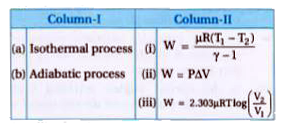Assertion: We cannot change the temperature of body without giving (or taking) heat to (or from) it.
Reason: According to principle of conservation of energy, total energy of a system should remains conserved.Solution in Gujrati
Both assertion and reason are true and the reason is the correct explanation of the assertion.
Both assertion and reason are true but reason is not the correct explanation of the assertion
The assertion is true but reason is false.
Assertion and reason both are false.
The correct Answer is:D
Step by step video, text & image solution for Assertion: We cannot change the temperature of body without giving (or taking) heat to (or from) it. Reason: According to principle of conservation of energy, total energy of a system should remains conserved. by Physics experts to help you in doubts & scoring excellent marks in Class 11 exams.
Topper's Solved these Questions
- BOOK - KUMAR PRAKASHANCHAPTER - THERMODYANMICS EXERCISE - Section-D Ncert Exemplar Solution (MCQs)6videos
THERMODYANMICS
- BOOK - KUMAR PRAKASHANCHAPTER - THERMODYANMICS EXERCISE - Section-D Ncert Exemplar Solution (MCQs More than one option )5videos
THERMODYANMICS
- BOOK - KUMAR PRAKASHANCHAPTER - THERMODYANMICS EXERCISE - Section-C (Objective Questions (Match))4videos
THERMODYANMICS
- BOOK - KUMAR PRAKASHANCHAPTER - THERMAL PROPERTIES OF MATTEREXERCISE - Question Paper (Section - D) (Answer following in brief :) Each carry 4 marks1videos
THERMAL PROPERTIES OF MATTER
- BOOK - KUMAR PRAKASHANCHAPTER - UNITS AND MEASUREMENTEXERCISE - Section -F (Questions from Module )20videos
UNITS AND MEASUREMENT
Similar Questions
An ideal gas undergoes four different processes from the same initial state as shown in figure of P-V diagram. Four processes are adiabatic, isothermal, isobaric and isochoric. Out of 1,2,3 and 4 which one is adiabatic ?
 01:05View Solution
01:05View SolutionWhich of the processes described below are irreversible ?
02:05View SolutionIn Column-I processes and in Column-II formulas of work are given. Match them appropriately :
 03:34View Solution
03:34View SolutionIn an experiment on the specific heat of a metal, a 0.20 kg block of the metal at 150∘C is dropped in a copper calorimeter (of water equivalent 0.025 kg) containing 150 cm3 of water at 27∘C. The final temperature is 40∘C. Compute the specific heat of the metal. If heat losses to the surroundings are not negligible, is your answer greater or smaller than the actual value for specific heat of the metal ?
01:07View SolutionIf the error in measurement of radius of a shpere is 2% then the error in determination of volume of the sphere will be …………
01:59View SolutionAssertion: According to law of conservation of machainical energy change in potential energy is equal and opposite to the change in kinetic energy
Reason: Mechanical energy is not a conserved quantity.07:44View SolutionAssertion : We can not change the temperature of a body without giving (or taking) heat to (or from) it. Reason : According to principle of conservation of energy, total energy of a system should remains conserved.
02:45View SolutionAssertion: Energy can neither be created nor destroyed. Reason: The principle of conservation of energy cannot be proved.
02:52View SolutionAssertion : In photon-particle collision the total energy and total momentum are conserved. Reason : The number of photons are conserved in a collision.
03:08View SolutionAccording to the Law of Conservation of Energy , as energy changes from one form to another form , the total energy of that system
04:05View Solutionऊर्जा संरक्षण के व्यापक सिद्धांत के अनुसार इस ब्रह्माण्ड की सम्पूर्ण ऊर्जा नियत रहती है, बताइए कि इस प्रक्रिया में क्या यह आवश्यक है कि सक्रिय बल संरक्षी ही होना चाहिए ?
03:09View SolutionAssertion : In elastic collision, kinetic energy is conserved. Reason : Energy is always conserved.
04:39View SolutionGive the principle of conservation of energy .
05:53View SolutionAssert the principle of energy conservation.
02:14View Solutionप्रक्कथन: किसी वस्तु को या वस्तु से ऊष्मा के आदान प्रदान के बगैर उसका ताप परिवर्तित नहीं कर सकते हैं।
कारण : ऊर्जा संरक्षण के सिद्धांत से एक निकाय की कुल ऊर्जा संरक्षित रहती है।01:05View Solution

